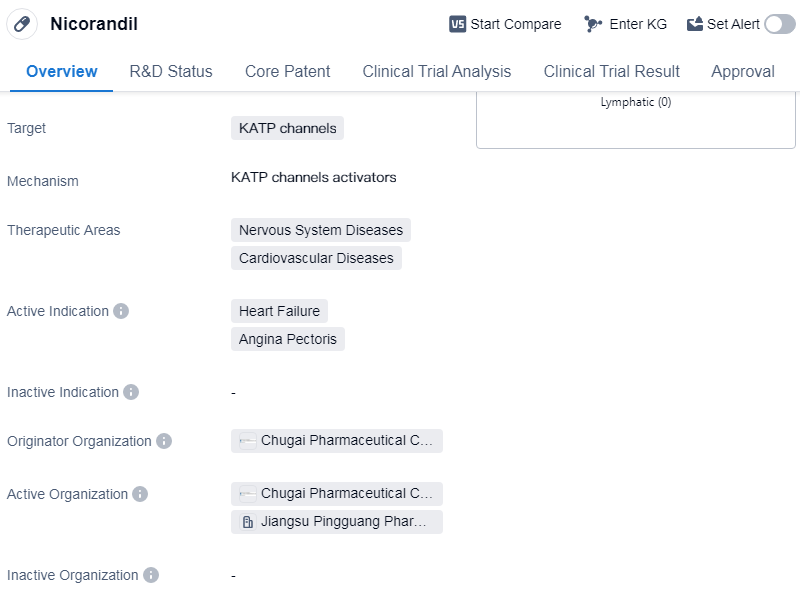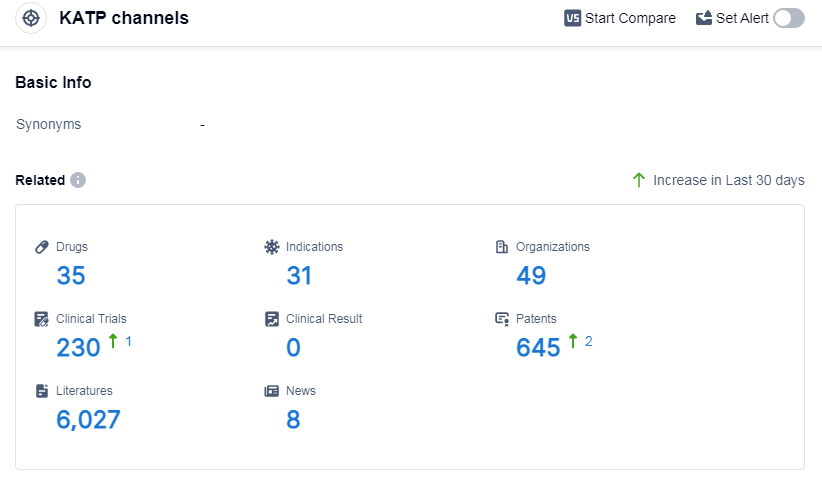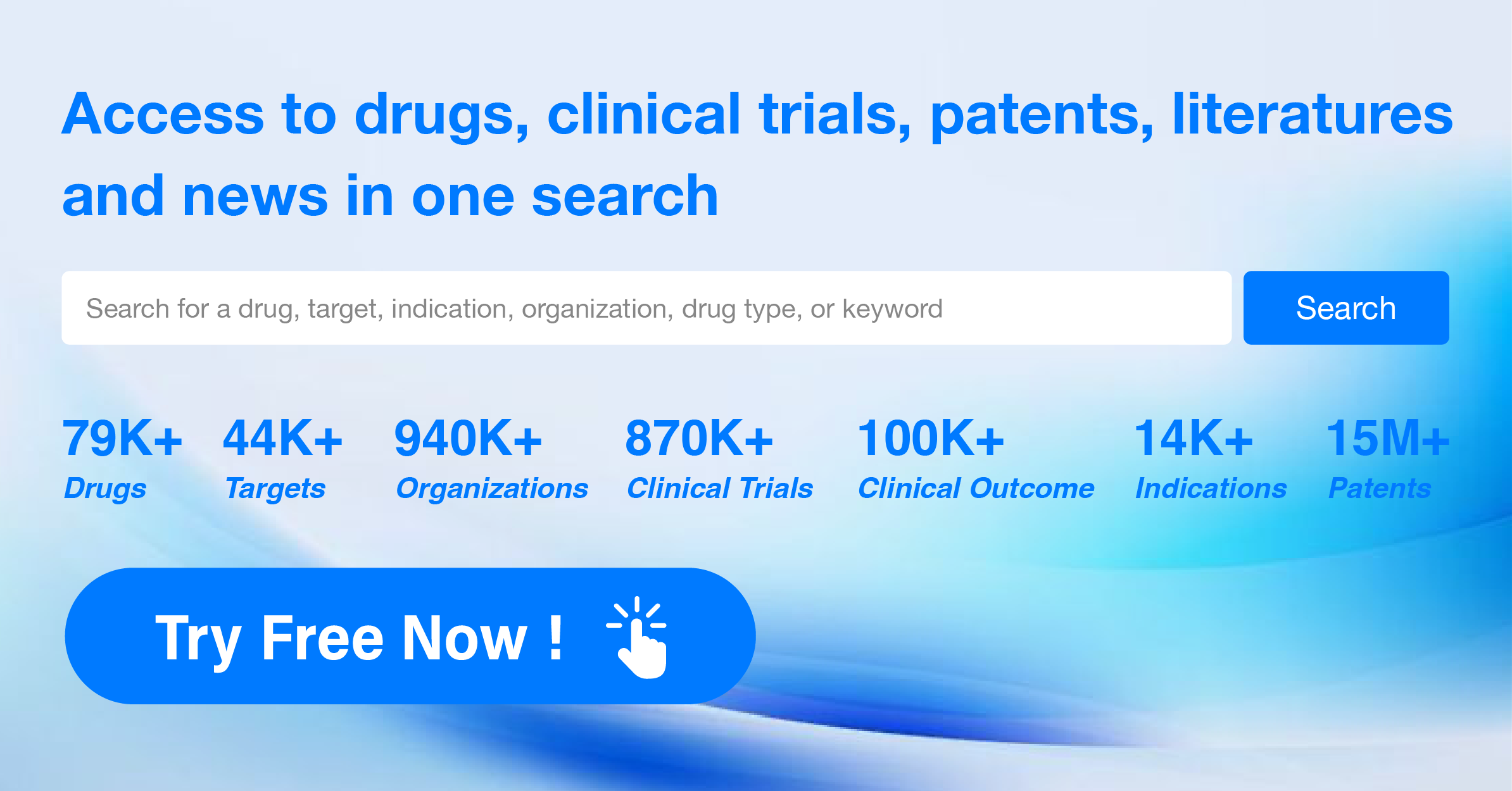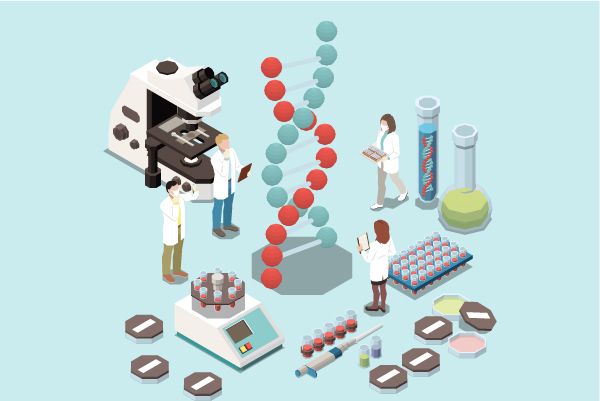Nicorandil Unveiled: A Detailed Overview of its Revolutionary R&D Breakthroughs
Nicorandil's R&D Progress
Nicorandil is a small molecule drug that targets ATP-sensitive potassium (KATP) channels and is used in the treatment of nervous system diseases and cardiovascular diseases. It is primarily indicated for heart failure and angina pectoris. The drug was developed by Chugai Pharmaceutical Co., Ltd., a pharmaceutical company based in Japan.
Nicorandil was first approved in Japan in September 1983, making it one of the earliest drugs in its class to receive regulatory approval. It has since been approved in other countries as well, indicating its global acceptance and recognition. The drug has also received approval in China, further expanding its market reach.
As a small molecule drug, Nicorandil is designed to interact with KATP channels, which are involved in the regulation of various cellular processes. By targeting these channels, the drug aims to provide therapeutic benefits in the treatment of nervous system diseases and cardiovascular diseases.
The primary therapeutic areas for Nicorandil are nervous system diseases and cardiovascular diseases. Heart failure and angina pectoris are the active indications for which the drug is primarily prescribed. Heart failure is a condition characterized by the heart's inability to pump enough blood to meet the body's needs, while angina pectoris refers to chest pain caused by reduced blood flow to the heart.
Chugai Pharmaceutical Co., Ltd. is the originator organization responsible for the development and commercialization of Nicorandil. As the originator, the company holds intellectual property rights and has conducted the necessary research and clinical trials to demonstrate the drug's safety and efficacy.
👇Please click on the image below to directly access the latest data (R&D Status | Core Patent | Clinical Trial | Approval status in Global countries) of this drug.
Mechanism of Action for Nicorandil: KATP Channels Activators
KATP channels activators are substances or drugs that stimulate or activate KATP channels. These channels are found in various tissues and play a critical role in regulating cellular excitability and metabolism.
From a biomedical perspective, ATP-sensitive potassium channels are ion channels that are sensitive to changes in cellular energy levels, particularly the ratio of ATP to ADP. These channels are present in many different cell types, including pancreatic beta cells, cardiac myocytes, and smooth muscle cells.
In pancreatic beta cells, KATP channels help regulate insulin secretion. When ATP levels are high, the channels close, leading to membrane depolarization and subsequent insulin release. On the other hand, when ATP levels are low, such as during hypoglycemia, the channels open, preventing excessive insulin secretion.
In cardiac myocytes, KATP channels are involved in protecting the heart during ischemic conditions. Opening of these channels leads to potassium efflux, which hyperpolarizes the cell membrane and reduces calcium influx. This ultimately helps maintain cellular energy balance and prevents excessive calcium overload, which can be detrimental to the heart during ischemia.
KATP channel activators are drugs or compounds that enhance the opening of these channels, leading to their activation. By doing so, they can have various therapeutic effects. For example, in the context of diabetes, KATP channel activators like sulfonylureas can stimulate insulin release from pancreatic beta cells, thereby helping to control blood glucose levels.
In summary, KATP channel activators are substances that stimulate ATP-sensitive potassium channels, which are involved in regulating cellular excitability and metabolism. They have important physiological roles in various tissues and can be targeted for therapeutic purposes in conditions such as diabetes and cardiac ischemia.
Drug Target R&D Trends for Nicorandil
According to Patsnap Synapse, as of 14 Sep 2023, there are a total of 35 KATP channels drugs worldwide, from 49 organizations, covering 31 indications, and conducting 230 clinical trials.
The analysis of the target KATP channels reveals a competitive landscape with multiple companies actively involved in research and development. GSK Plc, Sanofi, Eisai Co., Ltd., Kissei Pharmaceutical Co., Ltd., Roche Holding AG, China Resources Pharmaceutical Group Ltd.,and other organizationsare among the companies showing the fastest growth in this area.
Drugs targeting KATP channels have been approved for various indications, with type 2 diabetes mellitus being the most prominent. Small molecule drugs are the most rapidly progressing drug type under this target, indicating intense competition in the innovative drug market.
Japan, China, and the United States are leading in terms of drug development under the target KATP channels, with China showing significant progress. Other countries/locations also contribute to the development of drugs targeting KATP channels.
Overall, the target KATP channels present a competitive landscape with promising growth potential. Continued research and development efforts, especially in small molecule drugs, can lead to the development of innovative therapies for various indications, benefiting patients worldwide.
👇Please click on the picture link below for free registration or log in directly if you have a freemium account, you can browse the latest research progress on drugs, indications, organizations, clinical trials, clinical results, and drug patents related to this target
Conclusion
Overall, Nicorandil is a well-established small molecule drug that targets KATP channels and is used in the treatment of heart failure and angina pectoris. With its approval in multiple countries, including Japan and China, it has gained recognition as an effective therapeutic option for patients suffering from these conditions.






